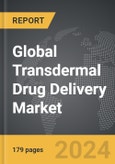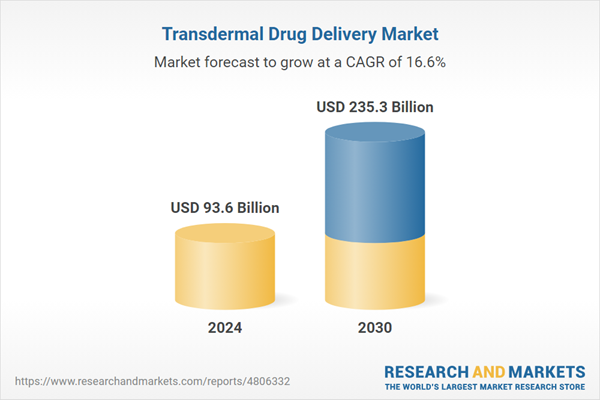The global market for Transdermal Drug Delivery was valued at US$93.6 Billion in 2024 and is projected to reach US$235.3 Billion by 2030, growing at a CAGR of 16.6% from 2024 to 2030. This comprehensive report provides an in-depth analysis of market trends, drivers, and forecasts, helping you make informed business decisions. The report includes the most recent global tariff developments and how they impact the Transdermal Drug Delivery market.
Segments: Delivery System (Passive, Active); Application (Analgesics, Hormone Replacement Therapy, Hypertension, Smoking Cessation, Other Applications).
Geographic Regions/Countries: World; United States; Canada; Japan; China; Europe (France; Germany; Italy; United Kingdom; and Rest of Europe); Asia-Pacific; Rest of World.
The analysts continuously track trade developments worldwide, drawing insights from leading global economists and over 200 industry and policy institutions, including think tanks, trade organizations, and national economic advisory bodies. This intelligence is integrated into forecasting models to provide timely, data-driven analysis of emerging risks and opportunities.
Global Transdermal Drug Delivery Market - Key Trends & Drivers Summarized
What is Transdermal Drug Delivery and Why is it Crucial?
Transdermal Drug Delivery is a method of administering medications through the skin in a controlled manner to achieve systemic effects. This delivery system is crucial for providing a non-invasive, convenient, and effective way of delivering drugs directly into the bloodstream, bypassing the gastrointestinal tract. Transdermal patches are the most common form of transdermal drug delivery systems, used to treat various conditions such as chronic pain, hormonal imbalances, and nicotine addiction. The significance of transdermal drug delivery lies in its ability to improve patient compliance, reduce the risk of side effects, and maintain consistent therapeutic drug levels over extended periods.How Does Transdermal Drug Delivery Improve Therapeutic Outcomes?
Transdermal Drug Delivery improves therapeutic outcomes by offering a controlled and sustained release of medication. This delivery method ensures that drugs are absorbed at a steady rate, maintaining optimal therapeutic levels in the bloodstream, which enhances efficacy and reduces the frequency of dosing. By bypassing the gastrointestinal tract, transdermal systems avoid issues such as gastric irritation and first-pass metabolism, which can degrade the drug before it reaches systemic circulation. This leads to better bioavailability and reduced dosage requirements. Additionally, transdermal patches are user-friendly and can be self-administered, improving patient adherence to prescribed treatment regimens. These benefits collectively contribute to more effective and reliable therapeutic outcomes.Why is the Demand for Transdermal Drug Delivery Systems Increasing?
The demand for Transdermal Drug Delivery systems is increasing due to several key factors. The rising prevalence of chronic diseases and conditions that require long-term medication management drives the need for convenient and effective drug delivery methods. Advances in drug formulation and skin penetration technologies have expanded the range of drugs that can be delivered transdermally, increasing their applicability. The focus on improving patient compliance and reducing the burden of frequent dosing regimens also fuels the demand for transdermal systems. Additionally, the non-invasive nature of transdermal drug delivery makes it an attractive option for patients who prefer to avoid injections or oral medications. The development of novel transdermal technologies and the growing acceptance of these systems in the healthcare industry further support their adoption.What Factors are Driving the Growth of the Transdermal Drug Delivery Market?
The growth in the Transdermal Drug Delivery market is driven by several factors. The increasing prevalence of chronic diseases and conditions requiring long-term medication creates a significant demand for effective and convenient drug delivery systems. Technological advancements in drug formulation, skin penetration enhancers, and patch design enhance the efficacy and range of transdermal delivery systems, driving their adoption. The focus on improving patient compliance and the need for non-invasive drug delivery options also contribute to market growth. The expanding applications of transdermal systems, including pain management, hormone replacement therapy, and smoking cessation, further boost demand. Additionally, favorable regulatory policies and the development of novel transdermal technologies support market expansion. The growing acceptance of transdermal drug delivery in the healthcare industry, coupled with ongoing research and development efforts to enhance their performance and reliability, underscores the market's potential for growth.Report Scope
The report analyzes the Transdermal Drug Delivery market, presented in terms of units. The analysis covers the key segments and geographic regions outlined below.Segments: Delivery System (Passive, Active); Application (Analgesics, Hormone Replacement Therapy, Hypertension, Smoking Cessation, Other Applications).
Geographic Regions/Countries: World; United States; Canada; Japan; China; Europe (France; Germany; Italy; United Kingdom; and Rest of Europe); Asia-Pacific; Rest of World.
Key Insights:
- Market Growth: Understand the significant growth trajectory of the Passive segment, which is expected to reach US$123.5 Billion by 2030 with a CAGR of a 15.1%. The Active segment is also set to grow at 18.4% CAGR over the analysis period.
- Regional Analysis: Gain insights into the U.S. market, valued at $26.3 Billion in 2024, and China, forecasted to grow at an impressive 15.7% CAGR to reach $35.6 Billion by 2030. Discover growth trends in other key regions, including Japan, Canada, Germany, and the Asia-Pacific.
Why You Should Buy This Report:
- Detailed Market Analysis: Access a thorough analysis of the Global Transdermal Drug Delivery Market, covering all major geographic regions and market segments.
- Competitive Insights: Get an overview of the competitive landscape, including the market presence of major players across different geographies.
- Future Trends and Drivers: Understand the key trends and drivers shaping the future of the Global Transdermal Drug Delivery Market.
- Actionable Insights: Benefit from actionable insights that can help you identify new revenue opportunities and make strategic business decisions.
Key Questions Answered:
- How is the Global Transdermal Drug Delivery Market expected to evolve by 2030?
- What are the main drivers and restraints affecting the market?
- Which market segments will grow the most over the forecast period?
- How will market shares for different regions and segments change by 2030?
- Who are the leading players in the market, and what are their prospects?
Report Features:
- Comprehensive Market Data: Independent analysis of annual sales and market forecasts in US$ Million from 2024 to 2030.
- In-Depth Regional Analysis: Detailed insights into key markets, including the U.S., China, Japan, Canada, Europe, Asia-Pacific, Latin America, Middle East, and Africa.
- Company Profiles: Coverage of players such as Antares Pharma, Inc., Bayer AG, Durect Corporation, Iontera, Inc., Janssen Pharmaceuticals, Inc. and more.
- Complimentary Updates: Receive free report updates for one year to keep you informed of the latest market developments.
Some of the 12 companies featured in this Transdermal Drug Delivery market report include:
- Antares Pharma, Inc.
- Bayer AG
- Durect Corporation
- Iontera, Inc.
- Janssen Pharmaceuticals, Inc.
- Nitto Denko Corporation
- Novartis AG
- Pantec Biosolutions AG
- Tesa Labtec GmbH
- Teva Pharmaceutical Industries Ltd.
Tariff Impact Analysis: Key Insights for 2025
Global tariff negotiations across 180+ countries are reshaping supply chains, costs, and competitiveness. This report reflects the latest developments as of April 2025 and incorporates forward-looking insights into the market outlook.The analysts continuously track trade developments worldwide, drawing insights from leading global economists and over 200 industry and policy institutions, including think tanks, trade organizations, and national economic advisory bodies. This intelligence is integrated into forecasting models to provide timely, data-driven analysis of emerging risks and opportunities.
What’s Included in This Edition:
- Tariff-adjusted market forecasts by region and segment
- Analysis of cost and supply chain implications by sourcing and trade exposure
- Strategic insights into geographic shifts
Buyers receive a free July 2025 update with:
- Finalized tariff impacts and new trade agreement effects
- Updated projections reflecting global sourcing and cost shifts
- Expanded country-specific coverage across the industry
Table of Contents
I. METHODOLOGYII. EXECUTIVE SUMMARY2. FOCUS ON SELECT PLAYERSIII. MARKET ANALYSISIV. COMPETITION
1. MARKET OVERVIEW
3. MARKET TRENDS & DRIVERS
4. GLOBAL MARKET PERSPECTIVE
UNITED STATES
CANADA
JAPAN
CHINA
EUROPE
FRANCE
GERMANY
ITALY
UNITED KINGDOM
REST OF EUROPE
ASIA-PACIFIC
REST OF WORLD
Companies Mentioned (Partial List)
A selection of companies mentioned in this report includes, but is not limited to:
- Antares Pharma, Inc.
- Bayer AG
- Durect Corporation
- Iontera, Inc.
- Janssen Pharmaceuticals, Inc.
- Nitto Denko Corporation
- Novartis AG
- Pantec Biosolutions AG
- Tesa Labtec GmbH
- Teva Pharmaceutical Industries Ltd.
Table Information
| Report Attribute | Details |
|---|---|
| No. of Pages | 179 |
| Published | April 2025 |
| Forecast Period | 2024 - 2030 |
| Estimated Market Value ( USD | $ 93.6 Billion |
| Forecasted Market Value ( USD | $ 235.3 Billion |
| Compound Annual Growth Rate | 16.6% |
| Regions Covered | Global |









